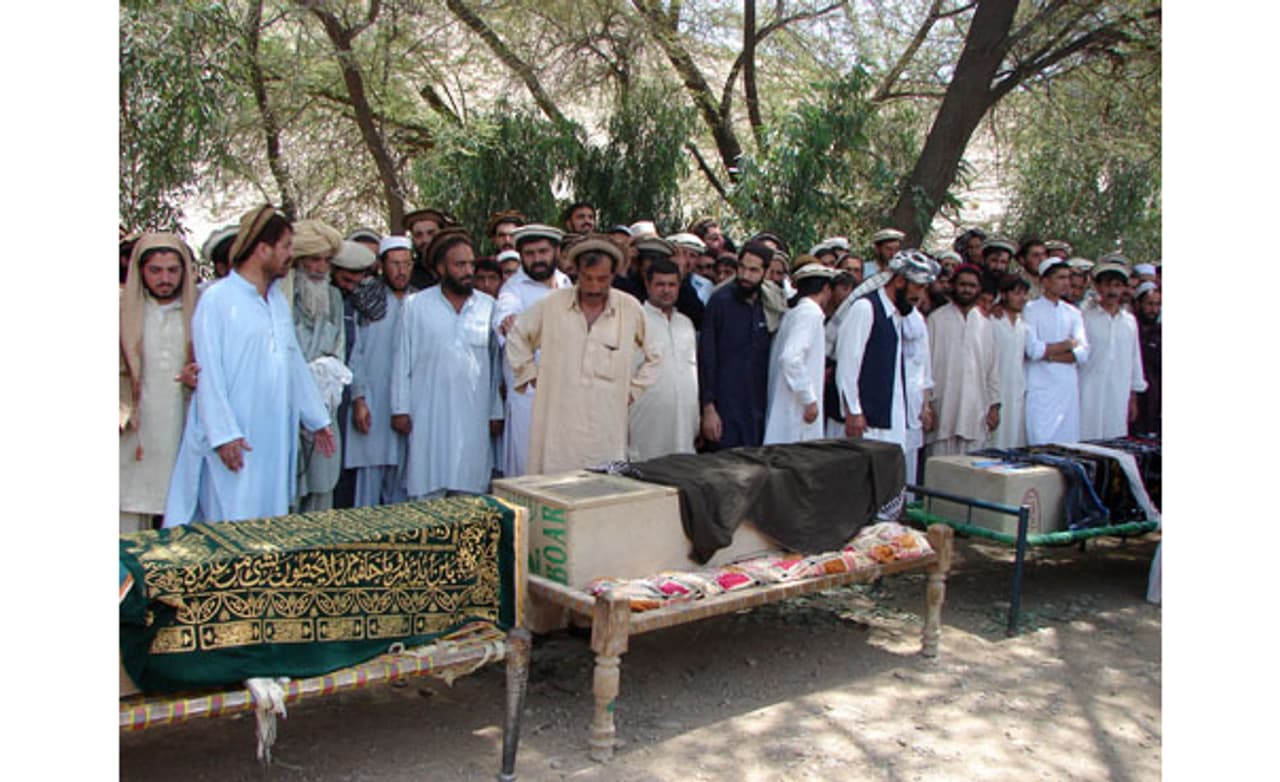
Naming the Dead project records the names of over 700 killed by drones in Pakistan
Tribesmen pay their respects at a funeral to victims of a strike on June 15 2011 (Photo: Thir Khan/AFP/Getty Images)
The Bureau of Investigative Journalism’s Naming the Dead project has now recorded the names of more than 700 people reportedly killed by CIA drones in Pakistan.
Nearly half – 323 – of the people identified are reported to be civilians, including 99 children. The database of names has grown since its launch last year, but those identified still make up fewer than one in three of the 2,342 reportedly killed in drone attacks.
See the Naming the Dead project
The Bureau uses open source materials to monitor and record all drone attacks in covert war situations including Pakistan. The data gathered reveals that at least 2,342 people have been killed in these attacks in the northern tribal areas of Pakistan. Of those killed at least 416 are reported to be civilians.
The US authorities claim that only militants are killed in drone strikes, but only 295 reported militants killed in drone strikes have been identified. There are an additional 95 people identified by the Bureau who are classed as ‘unknown’, where it is unclear whether they were civilians or members of a militant group. The Bureau has published case studies where details of the dead are known – but for many others, their name is almost all that is reported about them.
The Naming the Dead project gathers the names of people reportedly killed by CIA drones in Pakistan, along with any available biographical details – although often such details are scarce.
The project launched in September 2013, publishing 568 names of people killed in more than 370 drone strikes since 2004. This is the biggest publicly available list of drone victims, and draws on the thousands of media reports, court documents and other sources that inform the Bureau’s main drones databases.
The Bureau has since built on this, uncovering new names from eyewitness accounts gathered during a trip to Pakistan, leaked Pakistani government documents, and work by Bureau researchers in Pakistan.
And media reports have continued to identify drone strike victims, as happened last week with the latest additions to the database. They emerged after senior al Qaeda member Sanafi al Nasr eulogised three men killed on July 10.
Al Nasr, reportedly a member of Osama bin Laden’s extended family and a member of the organisation’s strategy committee, took to Twitter to lament the deaths of Fayez Awda al Khalidi, Taj al Makki and Abu Abdurahman al Kuwaiti.
Unnamed US intelligence sources told the Long War Journal that al Makki, a Saudi, and al Kuwaiti, from Kuwait, were mid-level al Qaeda commanders. The sources said the men were likely to be important people in al Qaeda because of their relationship with al Nasr.
In total, the Bureau has identified reports suggesting at least 168 children died in drone strikes, of whom it has identified 99 by name. This means around three-fifths of child drone victims have been identified so far. Sixty-seven of these names belong to children killed in a single attack, an October 2006 strike on a madrassa in Bajaur agency that killed 81 civilians.
Just two women killed by drones have been identified by name. One, Bibi Mamana, was a grandmother in her mid to late 60s. She was killed while tending to a field near her home; several of her grandchildren were also injured in the attack. The other is Raquel Burgos Garcia, the Spanish wife of al Qaeda member Amer Azizi. At least 55 women have been reported killed in the 10-year drone war, and as the Bureau reported last year, in the highly conservative culture of the tribal regions it is likely that many women’s deaths go entirely unreported.
Follow Jack Serle on Twitter – or to see what the team is reading, follow Drone Reads. Sign up for monthly updates from the Bureau’s Covert War project and subscribe to our podcast, Drone News from the Bureau.


